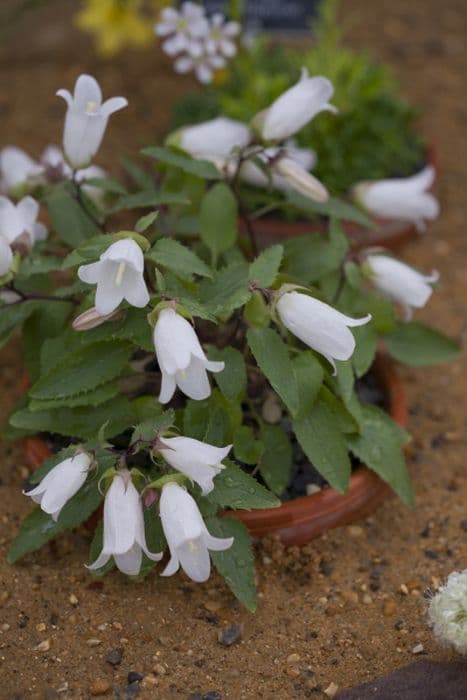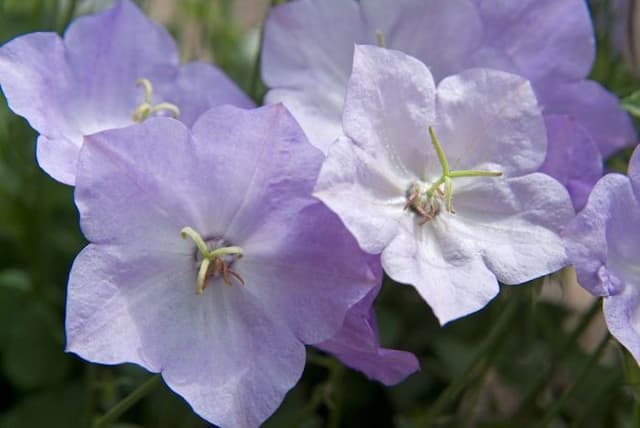Adriatic Bellflower Campanula fenestrellata

ABOUT
Campanula fenestrellata, commonly known as the Adriatic bellflower, is characterized by its showy, bell-shaped flowers that capture the eye. These flowers boast a radiant blue or violet hue often with a paler or white center, hanging gracefully from their stalks. The petals are fused, forming a distinct bell silhouette that's typical of the genus. The leaves of the Adriatic bellflower form a low-growing foliage mound. They have a heart-shaped or rounded base with toothed edges, and are typically lush green, sometimes with a hint of blue-green, which contrasts beautifully against the vibrant flowers. The plant gives off a delicate and charming appearance, creating a picturesque scene particularly when the flowers are in full bloom. The Adriatic bellflower tends to bloom during the warmer months, adding a splash of color to gardens, rockeries, and containers where they're often planted. The plant spreads readily, forming a semi-dense carpet that hugs the ground, offering a continuous cover of foliage interspersed with the striking blue-violet flowers. This makes it an attractive option for those wishing to add a touch of vivid color and charm to their planting arrangements without necessarily focusing on the vertical aspect of garden design.
About this plant
 Names
NamesFamily
Campanulaceae
Synonyms
Adriatic Bellflower, Fenestrella Bellflower, Dalmatian Bellflower
Common names
Campanula fenestrellata
 Toxicity
ToxicityTo humans
The Campanula fenestrellata, commonly known as Adriatic bellflower, is not known to be toxic to humans. These plants are generally considered safe, and there are no well-documented cases of poisoning from ingesting parts of this plant. Therefore, no specific symptoms of poisoning are associated with the Adriatic bellflower.
To pets
The Campanula fenestrellata, commonly known as Adriatic bellflower, is not known to be toxic to pets. It is generally considered non-toxic to cats and dogs. There are no specific symptoms associated with Adriatic bellflower toxicity in pets, as ingestion of this plant is not expected to cause any adverse effects. However, as with any non-food plant, ingestion in large quantities could potentially cause mild gastrointestinal upset, such as vomiting or diarrhea, simply due to the ingestion of non-digestible plant matter.
 Characteristics
CharacteristicsLife cycle
Perennials
Foliage type
Deciduous
Color of leaves
Green
Flower color
Blue
Height
0.5 feet (15 cm)
Spread
0.5 feet (15 cm)
Plant type
Herb
Hardiness zones
4
Native area
Europe
Benefits
 General Benefits
General Benefits- Aesthetic Appeal: Campanula fenestrellata, commonly known as Adriatic bellflower, adds color to gardens with its star-shaped blue flowers.
- Attracts Pollinators: Adriatic bellflower attracts bees, butterflies, and other pollinating insects, supporting local ecosystems.
- Ground Cover: This plant can form a mat-like coverage that helps to suppress weeds and reduce soil erosion.
- Drought Tolerance: Once established, the Adriatic bellflower can endure periods of low water, making it suitable for xeriscaping or dry gardens.
- Easy to Grow: This species is versatile and relatively low maintenance, making it suitable for novice gardeners.
- Edging Plants: Due to their compact growth, they can be used as border plants to define garden edges and pathways.
- Rock Gardens: They are an ideal choice for alpine and rock gardens, as they thrive in well-draining soils and can enhance the naturalistic design.
- Container Gardening: Campanula fenestrellata can be grown in pots, allowing those with limited space to enjoy its beauty.
- Seasonal Interest: With its bloom time in the summer, the plant contributes to the seasonal interest within a garden setting.
 Medical Properties
Medical PropertiesThis plant is not used for medical purposes.
 Air-purifying Qualities
Air-purifying QualitiesThis plant is not specifically known for air purifying qualities.
 Other Uses
Other Uses- Feeds pollinators: Campanula fenestrellata, commonly known as Adriatic bellflower, offers nectar and pollen for bees and butterflies, serving as a beneficial plant for pollinator gardens.
- Edible flowers: The blooms can be used as a decorative and subtly flavored addition to salads and desserts, although they are not commonly eaten.
- Photography subject: Due to its striking blue flowers, Adriatic bellflower is often used as a subject for botanical photography and plant illustration.
- Floral arrangements: Fresh or dried, the flowers can be incorporated into bouquets and other floral displays for a touch of delicate charm.
- Garden borders: The plant works well for creating edges and borders in rock gardens and alpine garden designs, due to its low growth habit.
- Fairy gardens: The small size and enchanting appearance of Adriatic bellflower make it suitable for use in miniature fairy garden landscapes.
- Crafting: The dried flowers can be used in crafting, such as making pressed flower art or for inclusion in homemade potpourri mixes.
- Teaching tool: Adriatic bellflower can be used in education to teach about plant growth, reproduction, and the importance of native species in ecosystem health.
- Ground cover: It can serve as a ground cover in sunny to partly shaded areas, helping to prevent soil erosion with its root system.
- Cultural symbolism: In certain cultures, Campanula species like the Adriatic bellflower are symbols of gratitude and everlasting love, making them a choice in thematic gardens or as gifts.
Interesting Facts
 Feng Shui
Feng ShuiThe Adria Bellflower is not used in Feng Shui practice.
 Zodiac Sign Compitability
Zodiac Sign CompitabilityThe Adria Bellflower is not used in astrology practice.
 Plant Symbolism
Plant Symbolism- Gratitude: Campanula fenestrellata, commonly known as Adriatic Bellflower, often symbolizes gratitude due to its bell-like flowers that seem to be bowing in graciousness.
- Constancy: The persistent blooming of Adriatic Bellflower through the summer seasons represents constancy and unwavering faith.
- Perseverance: The plant's ability to grow in rocky areas and thrive in crevices is seen as a symbol of perseverance and overcoming obstacles.
- Humility: With its low-growing habit and unassuming presence, the Adriatic Bellflower is often associated with humility.
 Water
WaterThe Campanula fenestrellata, commonly known as Adriatic Bellflower, requires regular watering to maintain moist soil, especially during the growing season. Water around the base of the plant, ensuring the water penetrates deeply to reach the roots. A general guideline is to provide the Adriatic Bellflower with approximately 1 inch of water per week, but this can vary depending on environmental conditions such as temperature and humidity. During hot, dry spells, you may need to water more frequently, while in cooler or rainy periods, less watering is necessary. Always check the top couple of inches of soil for moisture before watering again to avoid over-watering.
 Light
LightThe Adriatic Bellflower thrives in partial shade to full sun conditions. It prefers a spot that receives morning sunlight and is sheltered from the intense heat of the afternoon sun. However, if you live in a cooler climate, the plant can tolerate more sunlight. Place the Adriatic Bellflower in a location where it receives at least 4 to 6 hours of sunlight daily for optimal growth.
 Temperature
TemperatureThe Adriatic Bellflower performs well in a range of temperature conditions, but it prefers a moderate climate. The ideal temperature range for this plant is between 60°F and 75°F. It can survive minimum temperatures of around 30°F and maximum temperatures up to 85°F. However, prolonged periods outside this ideal temperature range can stress the plant.
 Pruning
PruningPruning the Adriatic Bellflower promotes a compact growth habit and encourages more blooms. Deadhead spent flowers regularly to encourage new blooms. Perform larger pruning tasks to shape the plant or remove any damaged or dead growth at the end of the flowering season or in early spring. Pruning is typically needed once or twice a year to maintain the plant's appearance and health.
 Cleaning
CleaningAs needed
 Soil
SoilThe Adriatic Bellflower, or Campanula fenestrellata, thrives in well-draining soil with a neutral to slightly alkaline pH level, around 7.0-7.5. A good potting mix would consist of equal parts loam, peat moss, and coarse sand or perlite to ensure adequate drainage and root aeration. Regular organic matter addition can maintain soil fertility.
 Repotting
RepottingAdriatic Bellflower should generally be repotted every 2 to 3 years to replenish the soil and allow room for growth. It is best to repot in the spring when the plant is actively growing.
 Humidity & Misting
Humidity & MistingAdriatic Bellflower prefers moderate to high humidity levels. Aim to maintain a humidity level of about 50-60% around the plant for optimal growth and health.
 Suitable locations
Suitable locationsIndoor
Place in bright indirect light, water when topsoil is dry.
Outdoor
Plant in partial shade, sheltered from intense sunlight.
Hardiness zone
4-7 USDA
 Life cycle
Life cycleCampanula fenestrellata, commonly known as the Adriatic bellflower, begins its life cycle with seed germination, typically occurring in spring when soil temperatures warm. Upon germination, it develops a basal rosette of leaves through which it undergoes vegetative growth. From this rosette, a flowering stalk arises, bearing star-shaped, blue flowers that typically bloom in the early to mid-summer. After pollination, which is often facilitated by insects, the flowers produce seed capsules containing numerous small seeds. These seeds are dispersed through mechanisms such as wind or rain, completing the cycle when they find suitable conditions to germinate. The Adriatic bellflower is a perennial plant, which means it can survive for several years, with each growing season seeing a new cycle of growth, flowering, seed production, and dormancy through the winter months.
 Propogation
PropogationPropogation time
Spring to early summer
Propogation: The most popular method of propagating Feathery Bellflower, or Campanula fenestrellata, is through seed sowing. The best time to sow seeds is in spring, once the danger of frost has passed and the soil has begun to warm up. To propagate, simply scatter the seeds on the surface of a well-draining seed starting mix and lightly press them into the soil. The seeds need light to germinate, so they should not be covered with soil. Keep the soil moist but not saturated by lightly misting it with water. Place the seed tray in a sunny spot, and germination should occur within two to three weeks. Once the seedlings have grown strong enough, they can be transplanted into individual pots or directly into the garden.








![Milky bellflower [Avalanche]](/_next/image?url=https%3A%2F%2Fplants-admin.emdemapps.com%2Fimages%2Fplants%2F%2Fimages%2F604b5dc88c1e7.png&w=640&q=75)
